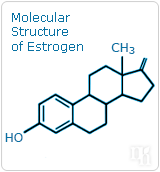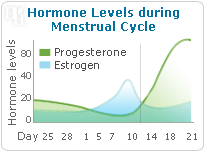
Estrogen is a complex group of compounds that is comprised of three elements. These estrogens are known as: estrone, estradiol, and estriol. Such estrogen is directly linked to everything to do with reproduction and a woman's fertility. For this reason, estrogen is found in much larger quantities in women, but it is still present in the biological makeup of men. Estrogen is fundamental to a woman's menstrual cycle and a lack of such an important chemical in the body can often wreak havoc on a menopausal woman's body.
Where in the Body Is Estrogen Produced?
Estrogen is primarily produced by developing egg follicles in the ovaries. Estrogen is also produced by the placenta and the corpus luteum. Smaller amounts of estrogen are produced by the breasts, adrenal glands, and the liver.
What Role Does Estrogen Play in the Body?
In order to understand the importance of estrogen for women, some background on its initial effects on women's body is important. Estrogen is vital in the early development of a woman's body and shapes.
Also, estrogen helps other physical features. The presence of estrogen means that women have smoother skin and less facial hair than men.
Estrogen and Pregnancy

Estrogen works in the body to:
- Control ovulation
- Prepare a woman's body for pregnancy by thickening the endometrium
Estrogen in Relation to Menopause
Estrogen is an aspect of women's bodies; as women age, their ability to reproduce estrogen recedes, along with a woman's ability to reproduce. A lack of estrogen can cause other health problems and these are sometimes manifested by a collection of menopause symptoms. These can include mental symptoms such as:
- Depression
- Mood swings
- Irritability

And physical symptoms include:
- Vaginal dryness
- Changes in body odor
- Irregular heartbeat
Treatments for a Lack of Estrogen
Many women turn to treatment methods such as hormone replacement therapy (HRT) or phytoestrogenic supplements in order to stave off the embarrassing or painful effects of menopause. These methods work by introducing estrogen into the body. For HRT, this estrogen is derived from the urine of pregnant horses while the estrogen from phytoestrogenic supplements, is sourced from plant like hormones with a chemical structure similar to a human estrogen. Both treatment methods come with a number of side effects; however, such side effects should be weighed carefully in any decision to choose a particular treatment method.
What are the alternative treatment methods for a lack of estrogen? Using methods such as HRT or phytoestrogenic supplements entails a risk that many women are not willing to take. To this end, many women turn to the alternative treatments such as hormone-regulating supplements, which contain many of the benefits of phytoestrogenic herbs, but without the harmful effects.